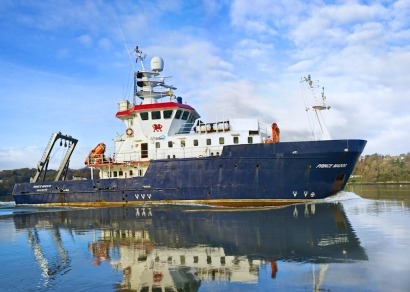The project is part of the Clean Maritime Demonstration Competition Round 3 (CMDC3), funded by the Department for Transport in partnership with Innovate UK. It will be delivered by a consortium of major UK innovators in green maritime technology and hydrogen systems, led by
O.S Energy who own and operate a fleet of dedicated offshore service vessels.
Other consortium partners include
H2Tec, part of Edinburgh-based hydrogen technologies expert
Logan Energy, as well as Solis Marine Engineering, Newcastle Marine Services, Chartwell Marine, Cedar Marine, Stone Marine Propulsions and the universities of Exeter and Newcastle-Upon-Tyne.
The Prince Madog, based at Bangor University in Wales, recently celebrated 20 years of service to education and science. The research vessel has changed the way we understand marine and coastal sciences and is one of the largest such ships in Europe.
The new hydrogen propulsion system, which will work in conjunction with a diesel-fuelled main engine, will enable zero emission operation at slow speeds or over short distances - such as daily teaching trips with the students from the School of Ocean Sciences at Bangor University. In normal operation, the hybrid system and new novel propulsion design will reduce emissions by up to 60%.
According to Offshore Renewable Energy Catapult (OREC), it is estimated the offshore support sector will be worth £26 billion by 2050 and that an additional 1,200 vessels will be needed to service the UK’s industry and support the transition to net zero by 2050.
Around 90% of all consumables are moved by sea and the shipping industry globally is responsible for 940 million tonnes of CO2 - the equivalent of at least 2.5% of the world’s total CO2 emissions.
The International Maritime Organization has set a target to cut these emissions by 50% by 2050 and the UK government is the first in the world to include emissions from international shipping in its domestic carbon budget.
Martin Nuernberg, Managing Director of O.S. Energy (UK), said, "OS Energy is thrilled to be leading this ground-breaking project assembling a strong consortium of industry leading innovators to push the boundaries of traditional maritime propulsion systems and paving the way for a cleaner and more sustainable future for the shipping industry.
"The Transship II project is a testament to our commitment to innovation and environmental responsibility and will demonstrate the potential of green technology application in the maritime industry."
Keigh Taylor, Managing Director of H2Tec, said, “This is a very exciting project for H2Tec and our partners. We believe hydrogen power is a great solution for the maritime industry which needs to drastically reduce its CO2 emissions.
"The project is an ideal opportunity to demonstrate innovative new refuelling technology and provide a vision for the future of shipping.”
The Prince Madog, a multi-purpose research vessel used to conduct marine research along the British coastline and in the Irish and Celtic Seas, is the UK’s only fully seagoing higher education research ship and is commonly used to train future marine scientists at Bangor University and further afield.
The retrofit work, which will take up to two years, is set to begin in April. Once complete, the Prince Madog will receive hydrogen from the Holyhead Hydrogen Hub on Anglesey, North Wales.


